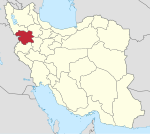Sanandaj
Sanandaj
| |
|---|---|
City | |
| File:Sanandaj 2020.jpg | |
| Coordinates: 35°18′52″N 46°59′32″E / 35.31444°N 46.99222°E | |
| Country | |
| Province | Kurdistan |
| County | Sanandaj |
| Bakhsh | Central |
| Government | |
| • Mayor | Heshmatollah Seydi |
| Area | |
• City | 3,033 km2 (1,171 sq mi) |
| Elevation | 1,538 m (5,046 ft) |
| Population (2016 Census) | |
| • Urban | 412,767 [1] |
| Time zone | UTC+3:30 (IRST) |
| • Summer (DST) | UTC+4:30 (IRDT) |
| Area code | 087 |
| Climate | Csa |
| Website | e-sanandaj |

Sanandaj (Template:Lang-ku; Template:IPA-sdh; Template:Lang-fa); Template:Lang-syr, often romanized as Senneh,[2] previously known as Sena Dezh [3][4][5] is the capital of Kurdistan Province in Iran. With a population of 414,069,[6] Sanandaj is the twenty third largest city in Iran and the second largest Kurdish city. Sanandaj's founding is fairly recent, (about 250 years ago), yet under its short existence it has grown to become one of the centers of Kurdish culture.[7][8] During the Iraq-Iran War the city was attacked by Iraqi planes and saw disturbances.[9]
From 2019 UNESCO has recognized Sineh (Sanandaj) as Creative City of Music.[10]
Name
The city of Sanandaj was originally called Saneh, and because it was located near an important castle it was later called Sanehdaj, meaning castle at the foot of a mountain. This presumably turned into Sanandaj over time.[11]
People
The population of Sanandaj is mainly Kurdish. The city also had an Armenian minority who gradually emigrated from the city. Until the Iranian Revolution (1979), the city had a small Aramaic-speaking Jewish community of about 4,000 people.[7] The city boasted a sizable Assyrian community that spoke a unique dialect of Aramaic called Senaya. The economy of Sanandaj is based upon the production of carpets, processed hides and skins, milled rice, refined sugar, woodworking, cotton weaving, metalware and cutlery.[12][13]
Most of the people of Sanandaj follow the Shafi‘i branch of Sunni Islam.[14]
The Ardalani dialect of Kurdish is spoken in Sanandaj and its surroundings. Ardalani dialect is distinct to Kurdistan province and is spoken in Sanandaj and other cities of Kurdistan province. The other important dialect of Sorani Kurdish is Mokriani which is spoken in Mokrian region in Piranshahr & Mahabad in West Azerbaijan province.
During the Iranian revolution, HDK and Komalah took control over the city under a brief period of time.[citation needed]
Historic
In his book Median History, Diakonov writes: The upper part of the Diyala River and its tributaries and branches in the triangle of the present cities of Sulaimaniyah, Sanandaj and Sarpol-e Zahab have been called Parsua since the mid-ninth century[15]
Climate
Sanandaj has a humid continental climate (Dsa) according to the Köppen climate classification with short, cold, and wet winters and long, hot, and dry summers.
| Climate data for Sanandaj | |||||||||||||
|---|---|---|---|---|---|---|---|---|---|---|---|---|---|
| Month | Jan | Feb | Mar | Apr | May | Jun | Jul | Aug | Sep | Oct | Nov | Dec | Year |
| Mean daily maximum °C (°F) | 4.9 (40.8) |
6.9 (44.4) |
13.1 (55.6) |
19.1 (66.4) |
25.2 (77.4) |
32.3 (90.1) |
36.8 (98.2) |
36.1 (97.0) |
31.6 (88.9) |
23.9 (75.0) |
15.6 (60.1) |
8.5 (47.3) |
21.2 (70.1) |
| Mean daily minimum °C (°F) | −6.2 (20.8) |
−4.8 (23.4) |
0.1 (32.2) |
4.5 (40.1) |
8.2 (46.8) |
12.2 (54.0) |
17.1 (62.8) |
16.4 (61.5) |
10.4 (50.7) |
5.8 (42.4) |
1.1 (34.0) |
−3 (27) |
5.1 (41.3) |
| Average precipitation mm (inches) | 71.8 (2.83) |
67.7 (2.67) |
86.9 (3.42) |
73.1 (2.88) |
42.5 (1.67) |
1.8 (0.07) |
0.4 (0.02) |
0.7 (0.03) |
0.8 (0.03) |
29.2 (1.15) |
57.3 (2.26) |
58.4 (2.30) |
490.6 (19.33) |
| Average precipitation days | 12.4 | 12.0 | 13.3 | 12.0 | 9.0 | 1.0 | 0.3 | 1.0 | 0.8 | 5.8 | 8.2 | 10.9 | 86.7 |
| Source: World Meteorological Organisation | |||||||||||||
References
- ^ https://www.amar.org.ir/english
- ^ Senneh rug
- ^ https://conf.uok.ac.ir/fits2019/Venue/City-Sanandaj-en.aspx?Lang=fa
- ^ https://conf.uok.ac.ir/_JiroConference/Files/Conference/21/Common/ContentPage/Visit%20these%20attractions%20in%20Kurdistan.pdf
- ^ https://meteotrend.com/forecast/ir/sanandaj/
- ^ "آمار جمعیتی شهرستان سنندج :: فرمانداری سنندج".
- ^ a b Geoffrey Khan, The Jewish Neo-Aramaic Dialect of Sanandaj, Piscataway NJ: Gorgias Press, p. 1.
- ^ Sanandaj Encyclopædia Britannica, retrieved 16 July 2014.
- ^ https://www.britannica.com/place/Sanandaj
- ^ https://en.unesco.org/creative-cities/events/sanandaj-one-year-anniversary-unesco-creative-city-music
- ^ حدیدی، عبدالعلی. «سنندج». در دانشنامه جهان اسلام. 21/10/1387. بازبینیشده در 2012-07-20.
- ^ "کردستان از نظر نرخ بیکاری در جایگاه دوم کشور قرار گرفت". yjc.ir. Retrieved 14 May 2016.
- ^ "سرمایهگذاری در صنعت و معدن کردستان، 4 برابر کمتر از متوسط کشوری است". sanayenews.com. Retrieved 14 May 2016.
- ^ https://www.iranhumanrights.org/2017/11/intelligence-ministry-invites-rouhani-campaign-manager-to-stop-advocating-for-sunni-muslim-rights/
- ^ BC.Diakonoff, I. M. (1985), "Media", The Cambridge History of Iran, 2 (Edited by Ilya Gershevitch ed.), Cambridge, England: Cambridge University Press, ISBN 978-0-521-20091-2
External links



